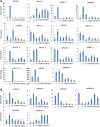Identification and characterization of miRNAome in root, stem, leaf and tuber developmental stages of potato (Solanum tuberosum L.) by high-throughput sequencing
- PMID: 24397411
- PMCID: PMC3913621
- DOI: 10.1186/1471-2229-14-6
Identification and characterization of miRNAome in root, stem, leaf and tuber developmental stages of potato (Solanum tuberosum L.) by high-throughput sequencing
Abstract
Background: MicroRNAs (miRNAs) are ubiquitous components of endogenous plant transcriptome. miRNAs are small, single-stranded and ~21 nt long RNAs which regulate gene expression at the post-transcriptional level and are known to play essential roles in various aspects of plant development and growth. Previously, a number of miRNAs have been identified in potato through in silico analysis and deep sequencing approach. However, identification of miRNAs through deep sequencing approach was limited to a few tissue types and developmental stages. This study reports the identification and characterization of potato miRNAs in three different vegetative tissues and four stages of tuber development by high throughput sequencing.
Results: Small RNA libraries were constructed from leaf, stem, root and four early developmental stages of tuberization and subjected to deep sequencing, followed by bioinformatics analysis. A total of 89 conserved miRNAs (belonging to 33 families), 147 potato-specific miRNAs (with star sequence) and 112 candidate potato-specific miRNAs (without star sequence) were identified. The digital expression profiling based on TPM (Transcripts Per Million) and qRT-PCR analysis of conserved and potato-specific miRNAs revealed that some of the miRNAs showed tissue specific expression (leaf, stem and root) while a few demonstrated tuberization stage-specific expressions. Targets were predicted for identified conserved and potato-specific miRNAs, and predicted targets of four conserved miRNAs, miR160, miR164, miR172 and miR171, which are ARF16 (Auxin Response Factor 16), NAM (NO APICAL MERISTEM), RAP1 (Relative to APETALA2 1) and HAM (HAIRY MERISTEM) respectively, were experimentally validated using 5' RLM-RACE (RNA ligase mediated rapid amplification of cDNA ends). Gene ontology (GO) analysis for potato-specific miRNAs was also performed to predict their potential biological functions.
Conclusions: We report a comprehensive study of potato miRNAs at genome-wide level by high-throughput sequencing and demonstrate that these miRNAs have tissue and/or developmental stage-specific expression profile. Also, predicted targets of conserved miRNAs were experimentally confirmed for the first time in potato. Our findings indicate the existence of extensive and complex small RNA population in this crop and suggest their important role in pathways involved in diverse biological processes, including tuber development.
Figures








Similar articles
-
Identification and characterization of miRNA transcriptome in potato by high-throughput sequencing.PLoS One. 2013;8(2):e57233. doi: 10.1371/journal.pone.0057233. Epub 2013 Feb 21. PLoS One. 2013. PMID: 23437348 Free PMC article.
-
Genome-wide identification and characterization of microRNAs by small RNA sequencing for low nitrogen stress in potato.PLoS One. 2020 May 19;15(5):e0233076. doi: 10.1371/journal.pone.0233076. eCollection 2020. PLoS One. 2020. PMID: 32428011 Free PMC article.
-
Identification and expression profiling of Vigna mungo microRNAs from leaf small RNA transcriptome by deep sequencing.J Integr Plant Biol. 2014 Jan;56(1):15-23. doi: 10.1111/jipb.12115. Epub 2013 Dec 19. J Integr Plant Biol. 2014. PMID: 24138283
-
Role of microRNAs and their putative mechanism in regulating potato (Solanum tuberosum L.) life cycle and response to various environmental stresses.Plant Physiol Biochem. 2024 Feb;207:108334. doi: 10.1016/j.plaphy.2024.108334. Epub 2024 Jan 3. Plant Physiol Biochem. 2024. PMID: 38219424 Review.
-
Plant small RNAs: advancement in the understanding of biogenesis and role in plant development.Planta. 2018 Sep;248(3):545-558. doi: 10.1007/s00425-018-2927-5. Epub 2018 Jul 2. Planta. 2018. PMID: 29968061 Review.
Cited by
-
Identification and characterization of miRNAome and target genes in Pseudostellaria heterophylla.PLoS One. 2022 Oct 5;17(10):e0275566. doi: 10.1371/journal.pone.0275566. eCollection 2022. PLoS One. 2022. PMID: 36197881 Free PMC article.
-
Integrated Analysis of microRNA and RNA-Seq Reveals Phenolic Acid Secretion Metabolism in Continuous Cropping of Polygonatum odoratum.Plants (Basel). 2023 Feb 19;12(4):943. doi: 10.3390/plants12040943. Plants (Basel). 2023. PMID: 36840290 Free PMC article.
-
Functional genomics of tomato: opportunities and challenges in post-genome NGS era.J Biosci. 2014 Dec;39(5):917-29. doi: 10.1007/s12038-014-9480-6. J Biosci. 2014. PMID: 25431420 Review.
-
Transcriptome profiling of root microRNAs reveals novel insights into taproot thickening in radish (Raphanus sativus L.).BMC Plant Biol. 2015 Feb 3;15:30. doi: 10.1186/s12870-015-0427-3. BMC Plant Biol. 2015. PMID: 25644462 Free PMC article.
-
A Deluge of Complex Repeats: The Solanum Genome.PLoS One. 2015 Aug 4;10(8):e0133962. doi: 10.1371/journal.pone.0133962. eCollection 2015. PLoS One. 2015. PMID: 26241045 Free PMC article.
References
Publication types
MeSH terms
Substances
LinkOut - more resources
Full Text Sources
Other Literature Sources
Molecular Biology Databases
Research Materials

